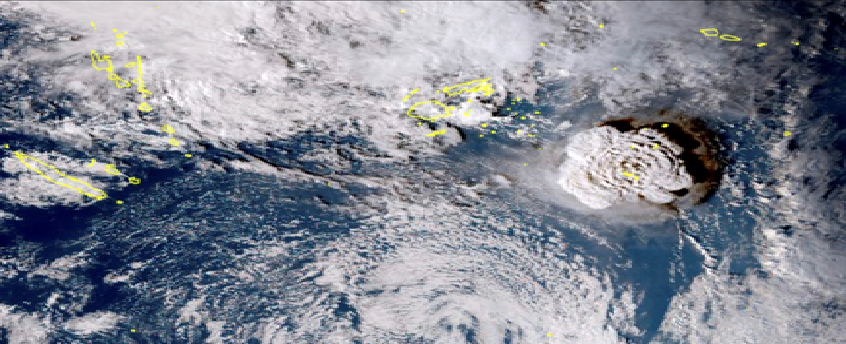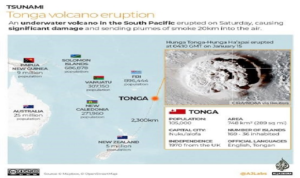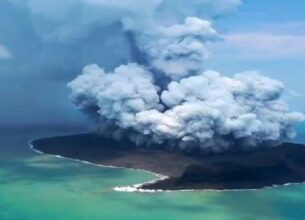Tonga Volcanic Eruption
19, Jan 2022

Prelims level : Geomorphology
Mains level : GS-III Important Geophysical Phenomena Such as Earth Quakes, Tsunami, Volcanic Activity, Cyclone Etc., Geographical features and their Locations-Changes in Critical Geographical Features (Including Water Bodies and Ice Caps) and In Flora and Fauna and the Effects of Such Changes.
Why in News?
- Recently, a volcano erupted in the southern Pacific Island of Tonga, which triggered Tsunami waves around the Pacific.
About the News:
- It is an Undersea Volcanic Eruption consisting of two small uninhabited islands, Hunga-Ha’apai and Hunga-Tonga.
- The Tonga Islands occur along the Ring of Fire—a perimeter of heightened volcanic and seismic activity that encircles the Pacific Ocean basin.
What is the Ring of Fire?
- The Ring of Fire is a Pacific region home to over 450 volcanoes, including three of the world’s four most active volcanoes – Mount St. Helens in the USA, Mount Fuji in Japan and Mount Pinatubo in the Philippines. It is also sometimes called the circum-Pacific belt.
- Around 90% of the world’s Earthquakes occur in the Ring of Fire, and 80% of the world’s Largest Earthquakes.

Location:
- It stretches along the Pacific Ocean coastlines, where the Pacific Plate grinds against other, smaller tectonic plates that form the Earth’s crust – such as the Philippine Sea plate and the Cocos and Nazca Plates that line the edge of the Pacific Ocean.

- The 40,000 kilometre horse-shoe-shaped ring loops from New Zealand to Chile, passing through the coasts of Asia and the Americas on the way.
Risk:
- The people most at risk from activity in the Ring of Fire are in the US west coast, Chile, Japan and island nations including the Solomon Islands.
- These areas are most at risk because they lie on so-called subduction zones – which are boundaries that mark the collision between two of the planet’s tectonic plates.
How was the Ring of Fire formed?
- The Ring of Fire is the result from subduction of Oceanic Tectonic Plates beneath lighter Continental Plates. The area where these Tectonic Plates meet is called a subduction zone.
Why does the Ring of Fire Trigger Earthquakes?
- The world’s deepest earthquakes happen in subduction zone areas as tectonic plates scrape against each other – and the Ring of Fire has the world’s biggest concentration of subduction zones.
- As energy is released from the earth’s molten core, it forces tectonic plates to move and they crash up against each other, causing friction. The friction causes a build-up of energy and when this energy is finally released it causes an earthquake. If this happens at sea it can cause devastating tsunamis.
- Tectonic plates usually only move on average a few centimetres each year, but when an earthquake strikes, they speed up massively and can move at several metres per second.







